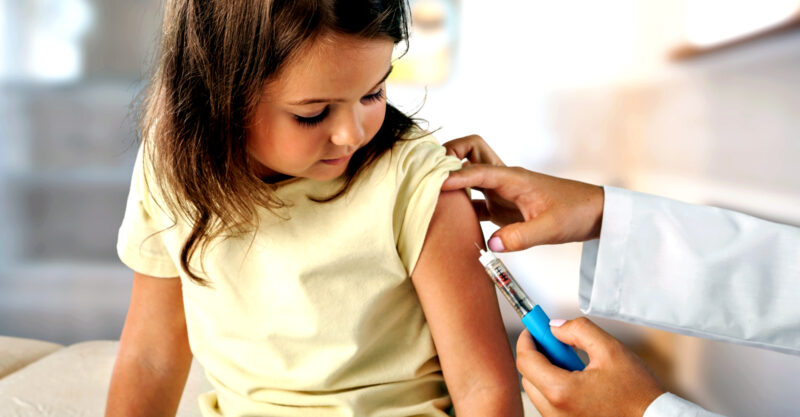Miss a day, miss a lot. Subscribe to The Defender's Top News of the Day. It's free.
The number of serious adverse reactions to the Pfizer-BioNTech COVID-19 vaccine was more than four times greater than the number of children needing oxygen therapy to recover from the virus, according to a study involving more than a quarter million children ages 5 to 11.
The data raise questions about the risk-benefit analysis for the vaccination against COVID-19 in children ages 5 to 11, according to John Campbell, Ph.D., a nurse teacher from the U.K. who reviewed the study in his latest video.
“Let’s hope the policymakers are completely up-to-date with this data,” said Campbell, who is described by German and British media as an expert on vaccine administration.
The study, based on data collected in Singapore from Jan. 21 through April 8, when the Omicron variant was spreading rapidly, included 22 cases of serious adverse reactions to the Pfizer vaccine in children ages 5 to 11 and only five cases of children needing oxygen therapy.
All but one of the children who required oxygen therapy were fully or partially vaccinated, suggesting the vaccine offers no protection against needing oxygen therapy, Campbell said.
“Among hospitalized children,” the study authors said, “only five received supplemental oxygen, four of whom were admitted to the intensive care unit. Of these five children, one was unvaccinated, two were partially vaccinated, and two were fully vaccinated.”
They added:
“No deaths attributable to COVID-19 (as determined by the cause of death reported to the Ministry of Health) were observed during the study period.”
Summary of study
The authors of the study, published July 20 in The New England Journal of Medicine, conducted statistical analyses to estimate the effectiveness of the Pfizer BNT162b2 vaccine against Omicron in children ages 5 to 11 in Singapore from Jan. 21 through April 8.
The team — including Kelvin B. Tan, Ph.D., director of policy research and evaluation at Singapore’s Ministry of Health, and Sharon H. X. Tan, M.P.H., research fellow at the National University of Singapore and colleagues — looked at the incidence of COVID-19 infections and hospitalizations related to COVID-19 among the more than a quarter million children in reference to their COVID-19 vaccination status.
Of the 255,936 children in the study, 67.6% were vaccinated (173,237), 12% (30,656) were partially vaccinated, 20.3% (52,043) were unvaccinated.
Children who had received a COVID-19 vaccine other than the Pfizer vaccine were excluded from the study.
The authors reported 288 COVID-19–related hospitalizations among the children.
They said the Pfizer vaccine effectiveness in partially vaccinated as compared with unvaccinated children was 13.6% (95% CI, 11.7 to 15.5) against all reported infections, 24.3% (95% CI, 19.5 to 28.9) against PCR-confirmed infections and 42.3% (95% CI, 24.9 to 55.7) against hospitalization.
In fully vaccinated children, the authors estimated vaccine effectiveness to be 36.8% (95% CI, 35.3 to 38.2) against all reported infections, 65.3% (95% CI, 62.0 to 68.3) against PCR-confirmed infections and 82.7% (95% CI, 74.8 to 88.2) against hospitalization.
The authors concluded vaccination reduced the risk of a COVID-19 infection and COVID-19–related hospitalization among children in the 5 to 11 age group.
The incidence rate of COVID-19 infections in children who were partially vaccinated was only 13.6% lower than in unvaccinated children and only 36.8% lower for children who were fully vaccinated compared to unvaccinated children.
Campbell: We need to ‘keep up-to-date with the evidence of the time’
Even though the study shows protection from the Pfizer vaccine against hospitalization overall, Campbell said the key numbers to consider are not the number of hospital admittances but the number of cases in which the child required oxygen therapy.
“No one is trying to minimize 288 hospitalizations in this group of children,” Campbell explained, “But remember — only 5 [children] needed oxygen.”
According to Campbell, the oxygen therapy number is more important than the rate of hospital admittance because “a lot [of these children] are being admitted on a precautionary basis.”
“We do this with children,” Campbell said. “We admit children much more readily than adults — at least I’ve always tended to do that — because we just don’t want to take any chances with children.”
But, he said, “It’s not so much the admissions to hospitals that might be considered the key thing — it’s how sick those children are.”
While receiving the vaccine reduced the chances of a child being admitted to a hospital, it did not reduce the child’s chances of needing oxygen or their chances of being admitted to intensive care “which are the most concerning outcomes,” Campbell said.
“There was no evidence for that,” he said.
Campbell said that the study is noteworthy because it used high-quality data. “The Singapore authorities are very good at collecting data.”
He emphasized this study is important because it used very recent data.
“Part of the problem is so much of the evidence we have is in previous waves [of COVID-19],” Campbell said.
“We’re now in Omicron times,” he said. “Things have changed and we need to move with times to keep up-to-date with the evidence of the time.”
Watch here:





